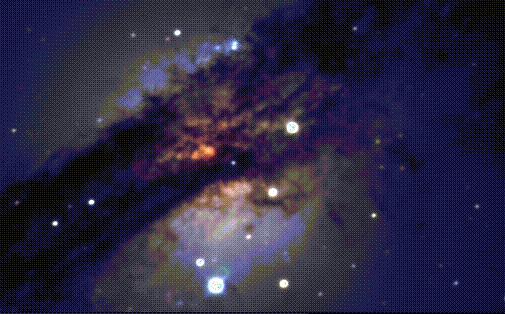Centaurus A
 The peculiar radio galaxy Centaurus A (NGC 5128) provides a striking
example of how dust can affect our view of a galaxy, and how going to redder
wavelengths helps penetrate interstellar dust. This color-composite CCD
image (from B, V, and R-band frames obtained with the 1.5-meter telescope
at Cerro Tololo) shows at once the reddening effects of dust in the
strong dust lane, some red emission from ionized gas at the H-alpha
line, and blue regions of star formation along the dust lane.
The dust blocks most of the light in the blue, and
progressively less going through the other wavelengths (and new
images deeper in the infrared show even less of the dust). This effect
against stars in our own galaxy is known as interstellar reddening,
though the effect in galaxies is complicated by the fact that some
of the light is not in fact absorbed but scattered in different directions
upon encountering a dust grain. Centaurus A is an unusually colorful
galaxy; note the very blue star clusters along the edges of the dust
lane, most prominent in the blue-light picture. This is widely held to
be an elliptical galaxy that has acquired a spiral by merger, with
the broad and gas-rich dust lane being the most visible debris of
the collision. This intricate dust structure, newly-formed star
clusters, and the obscured active nucleus are beautifully shown
in the
HST images released from WFPC2 and NICMOS data.
The peculiar radio galaxy Centaurus A (NGC 5128) provides a striking
example of how dust can affect our view of a galaxy, and how going to redder
wavelengths helps penetrate interstellar dust. This color-composite CCD
image (from B, V, and R-band frames obtained with the 1.5-meter telescope
at Cerro Tololo) shows at once the reddening effects of dust in the
strong dust lane, some red emission from ionized gas at the H-alpha
line, and blue regions of star formation along the dust lane.
The dust blocks most of the light in the blue, and
progressively less going through the other wavelengths (and new
images deeper in the infrared show even less of the dust). This effect
against stars in our own galaxy is known as interstellar reddening,
though the effect in galaxies is complicated by the fact that some
of the light is not in fact absorbed but scattered in different directions
upon encountering a dust grain. Centaurus A is an unusually colorful
galaxy; note the very blue star clusters along the edges of the dust
lane, most prominent in the blue-light picture. This is widely held to
be an elliptical galaxy that has acquired a spiral by merger, with
the broad and gas-rich dust lane being the most visible debris of
the collision. This intricate dust structure, newly-formed star
clusters, and the obscured active nucleus are beautifully shown
in the
HST images released from WFPC2 and NICMOS data.
 UA Astronomy Home Page
UA Astronomy Home Page
 The peculiar radio galaxy Centaurus A (NGC 5128) provides a striking
example of how dust can affect our view of a galaxy, and how going to redder
wavelengths helps penetrate interstellar dust. This color-composite CCD
image (from B, V, and R-band frames obtained with the 1.5-meter telescope
at Cerro Tololo) shows at once the reddening effects of dust in the
strong dust lane, some red emission from ionized gas at the H-alpha
line, and blue regions of star formation along the dust lane.
The dust blocks most of the light in the blue, and
progressively less going through the other wavelengths (and new
images deeper in the infrared show even less of the dust). This effect
against stars in our own galaxy is known as interstellar reddening,
though the effect in galaxies is complicated by the fact that some
of the light is not in fact absorbed but scattered in different directions
upon encountering a dust grain. Centaurus A is an unusually colorful
galaxy; note the very blue star clusters along the edges of the dust
lane, most prominent in the blue-light picture. This is widely held to
be an elliptical galaxy that has acquired a spiral by merger, with
the broad and gas-rich dust lane being the most visible debris of
the collision. This intricate dust structure, newly-formed star
clusters, and the obscured active nucleus are beautifully shown
in the
HST images released from WFPC2 and NICMOS data.
The peculiar radio galaxy Centaurus A (NGC 5128) provides a striking
example of how dust can affect our view of a galaxy, and how going to redder
wavelengths helps penetrate interstellar dust. This color-composite CCD
image (from B, V, and R-band frames obtained with the 1.5-meter telescope
at Cerro Tololo) shows at once the reddening effects of dust in the
strong dust lane, some red emission from ionized gas at the H-alpha
line, and blue regions of star formation along the dust lane.
The dust blocks most of the light in the blue, and
progressively less going through the other wavelengths (and new
images deeper in the infrared show even less of the dust). This effect
against stars in our own galaxy is known as interstellar reddening,
though the effect in galaxies is complicated by the fact that some
of the light is not in fact absorbed but scattered in different directions
upon encountering a dust grain. Centaurus A is an unusually colorful
galaxy; note the very blue star clusters along the edges of the dust
lane, most prominent in the blue-light picture. This is widely held to
be an elliptical galaxy that has acquired a spiral by merger, with
the broad and gas-rich dust lane being the most visible debris of
the collision. This intricate dust structure, newly-formed star
clusters, and the obscured active nucleus are beautifully shown
in the
HST images released from WFPC2 and NICMOS data.
 UA Astronomy Home Page
UA Astronomy Home Page